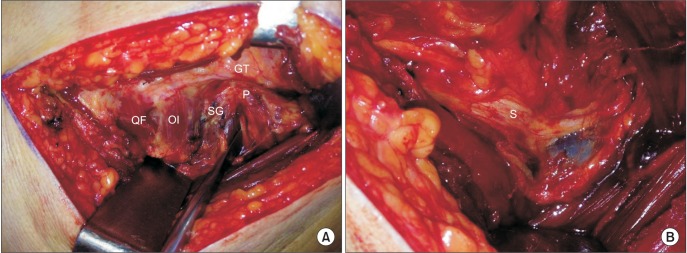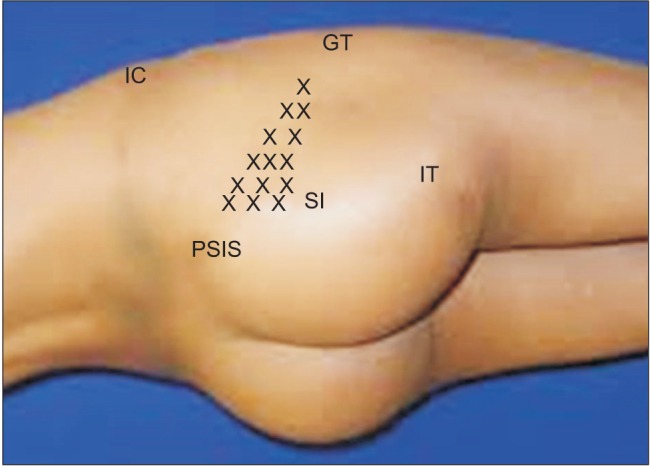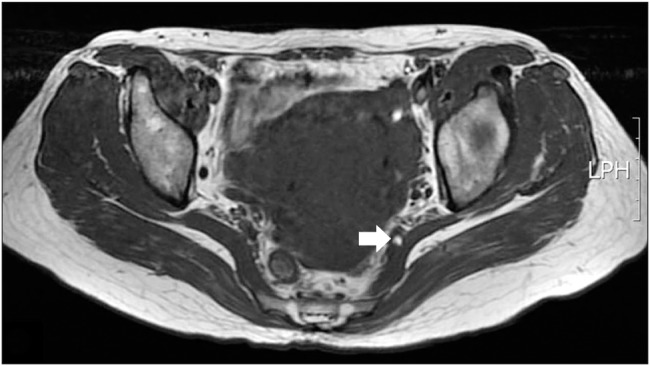Clin Orthop Surg.
2017 Jun;9(2):136-144. 10.4055/cios.2017.9.2.136.
Surgical Treatment of Piriformis Syndrome
- Affiliations
-
- 1Department of Orthopaedic Surgery, St. Paul's Hospital, College of Medicine, The Catholic University of Korea, Seoul, Korea. gamjang@catholic.ac.kr
- KMID: 2412280
- DOI: http://doi.org/10.4055/cios.2017.9.2.136
Abstract
- BACKGROUND
Piriformis syndrome (PS) is an uncommon disease characterized by symptoms resulting from compression/irritation of the sciatic nerve by the piriformis muscle. Uncertainty and controversy remain regarding the proper diagnosis and most effective form of treatment for PS. This study analyzes the diagnostic methods and efficacy of conservative and surgical treatments for PS.
METHODS
From March 2006 to February 2013, we retrospectively reviewed 239 patients who were diagnosed with PS and screened them for eligibility according to our inclusion/exclusion criteria. All patients underwent various conservative treatments initially including activity modification, medications, physical therapy, local steroid injections into the piriformis muscle, and extracorporeal shock wave therapy for at least 3 months. We resected the piriformis muscle with/without neurolysis of the sciatic nerve in 12 patients who had intractable sciatica despite conservative treatment at least for 3 months. The average age of the patients (4 males and 8 females) was 61 years (range, 45 to 71 years). The average duration of symptoms before surgery was 22.1 months (range, 4 to 72 months), and the mean follow-up period was 22.7 months (range, 12 to 43 months). We evaluated the degree of pain and recorded the responses using a visual analog scale (VAS) preoperatively and 3 days and 12 months postoperatively.
RESULTS
Buttock pain was more improved than sciatica with various conservative treatments. Compared with preoperatively, the VAS score was significantly decreased after the operation. Overall, satisfactory results were obtained in 10 patients (83%) after surgery.
CONCLUSIONS
PS is thought to be an exclusively clinical diagnosis, and if the diagnosis is performed correctly, surgery can be a good treatment option in patients with refractory sciatica despite appropriate conservative treatments.
MeSH Terms
Figure
Reference
-
1. Filler AG, Haynes J, Jordan SE, et al. Sciatica of nondisc origin and piriformis syndrome: diagnosis by magnetic resonance neurography and interventional magnetic resonance imaging with outcome study of resulting treatment. J Neurosurg Spine. 2005; 2(2):99–115. PMID: 15739520.
Article2. Ratnatunga K, Nardyasamy R, Siriwardena R, Prasad R, Deen K. Bilateral gluteal pain caused by piriformis muscle compartment syndrome in the greater sciatic foramen: a case report. Tech Coloproctol. 2010; 14(2):197–198. PMID: 20454823.
Article3. Brown JA, Braun MA, Namey TC. Pyriformis syndrome in a 10-year-old boy as a complication of operation with the patient in the sitting position. Neurosurgery. 1988; 23(1):117–119. PMID: 3173650.
Article4. Hopayian K, Song F, Riera R, Sambandan S. The clinical features of the piriformis syndrome: a systematic review. Eur Spine J. 2010; 19(12):2095–2109. PMID: 20596735.
Article5. Fishman LM, Dombi GW, Michaelsen C, et al. Piriformis syndrome: diagnosis, treatment, and outcome: a 10-year study. Arch Phys Med Rehabil. 2002; 83(3):295–301. PMID: 11887107.6. Benzon HT, Katz JA, Benzon HA, Iqbal MS. Piriformis syndrome: anatomic considerations, a new injection technique, and a review of the literature. Anesthesiology. 2003; 98(6):1442–1448. PMID: 12766656.7. Reus M, de Dios Berna J, Vazquez V, Redondo MV, Alonso J. Piriformis syndrome: a simple technique for US-guided infiltration of the perisciatic nerve: preliminary results. Eur Radiol. 2008; 18(3):616–620. PMID: 17972081.
Article8. Waseem Z, Boulias C, Gordon A, Ismail F, Sheean G, Furlan AD. Botulinum toxin injections for low-back pain and sciatica. Cochrane Database Syst Rev. 2011; (1):CD008257. PMID: 21249702.
Article9. Kirschner JS, Foye PM, Cole JL. Piriformis syndrome, diagnosis and treatment. Muscle Nerve. 2009; 40(1):10–18. PMID: 19466717.
Article10. Kim JE, Kim KH. Piriformis syndrome after percutaneous endoscopic lumbar discectomy via the posterolateral approach. Eur Spine J. 2011; 20(10):1663–1668. PMID: 21416279.
Article11. McCrory P, Bell S. Nerve entrapment syndromes as a cause of pain in the hip, groin and buttock. Sports Med. 1999; 27(4):261–274. PMID: 10367335.
Article12. Jankiewicz JJ, Hennrikus WL, Houkom JA. The appearance of the piriformis muscle syndrome in computed tomography and magnetic resonance imaging: a case report and review of the literature. Clin Orthop Relat Res. 1991; (262):205–209.13. Karl RD Jr, Yedinak MA, Hartshorne MF, et al. Scintigraphic appearance of the piriformis muscle syndrome. Clin Nucl Med. 1985; 10(5):361–363. PMID: 3160520.
Article14. Lee EY, Margherita AJ, Gierada DS, Narra VR. MRI of piriformis syndrome. AJR Am J Roentgenol. 2004; 183(1):63–64. PMID: 15208111.
Article15. Rossi P, Cardinali P, Serrao M, Parisi L, Bianco F, De Bac S. Magnetic resonance imaging findings in piriformis syndrome: a case report. Arch Phys Med Rehabil. 2001; 82(4):519–521. PMID: 11295014.
Article16. Sayson SC, Ducey JP, Maybrey JB, Wesley RL, Vermilion D. Sciatic entrapment neuropathy associated with an anomalous piriformis muscle. Pain. 1994; 59(1):149–152. PMID: 7854796.
Article17. Barton PM. Piriformis syndrome: a rational approach to management. Pain. 1991; 47(3):345–352. PMID: 1784505.
Article18. Tiel RL. Piriformis and related entrapment syndromes: myth & fallacy. Neurosurg Clin N Am. 2008; 19(4):623–627. PMID: 19010286.19. Miller TA, White KP, Ross DC. The diagnosis and management of Piriformis Syndrome: myths and facts. Can J Neurol Sci. 2012; 39(5):577–583. PMID: 22931697.
Article20. Cassidy L, Walters A, Bubb K, Shoja MM, Tubbs RS, Loukas M. Piriformis syndrome: implications of anatomical variations, diagnostic techniques, and treatment options. Surg Radiol Anat. 2012; 34(6):479–486. PMID: 22327640.
Article21. Michel F, Decavel P, Toussirot E, et al. Piriformis muscle syndrome: diagnostic criteria and treatment of a monocentric series of 250 patients. Ann Phys Rehabil Med. 2013; 56(5):371–383. PMID: 23684470.





